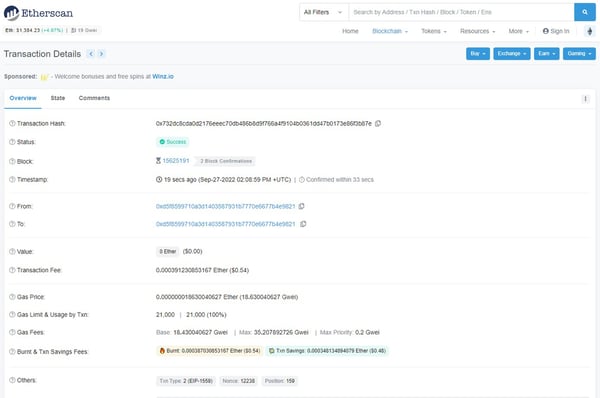A transaction is a signed (approved) record of change to a blockchain which is irreversible once validated. As previously discussed, each blockchain has their own consensus model, like a complex accounting transaction, which is one of the reasons it can become difficult to develop and maintain solutions across a number of different currencies and DeFi protocols. Each blockchain has it's own volume properties, with some like Aptos advertising high-volume transaction throughput vs. something like Bitcoin.
At its root, a transaction is responsible for taking a concrete and immutable action, such as moving coins or tokens from one wallet holder to another. Transactions have a number of properties and external factors that influence the operation. Below is a screenshot of a transaction on EtherScan, an Ethereum explorer, that allows you to see the information of a specific transaction hash.
The below image shows a typical transaction - continue reading to learn about what the descriptions mean!

Nonce
A nonce is an integer-based number that increments with every transaction request associated with a cryptocurrency wallet. It starts at zero when a wallet is first initialized, and when processing transactions, validation of the transaction will include checking that the nonce is the last validated nonce for your account + 1.
Understanding nonces is important as each currencies’ wallet transactions are processed in the order of their nonces. What this means is that if a transaction gets stuck due to low gas fees, any subsequently submitted transactions from that account will be held up until the first is processed. Occasionally it’s even required to resubmit a transaction with the same nonce as a previous transaction in order to cancel it.
Gas Fees
There’s no free lunch as they say, and the same is true for crypto. Even though the technology is distributed, there can still be substantial capital and operational costs associated with approving transactions. Gas fees are the real-time market costs required for the computation to process a transaction (in Proof-of-Work systems), and the payment rewarded to staking validators (in a Proof-of-Stake systems). If a transaction is submitted with the gas fee set too low, it will sit in the memory pool until market fees match what was set.
Knowing what gas fees to use, and how that impacts transaction performance and settlement is key to operating crypto infrastructure.
Mempool
The mempool is like a waiting room for transactions that have not yet been confirmed to the blockchain. To exit the mempool, a transaction must be validated in a block. Having a clear view into mempool queue sizes help to understand when transactions will clear, and also when to potentially adjust gas fees.
Canceling
Most blockchains do not allow a transaction to be canceled once submitted with approval. In order to ‘cancel’ a transaction, submitting a transaction of no value, with the same nonce as the transaction you wish to cancel, and a higher gas fee is required. You ultimately still pay a transaction fee, but the initial transaction data is not computed.
Verification Time
Mempool sizes, gas fees and how they’re changing, and current transaction nonce all effect the verification time of transactions. Ultimately the verification time is dependent on the above network performance and the specific gas fee paid.

.jpg?width=300&name=coreconcepttransactions%20(1).jpg)
